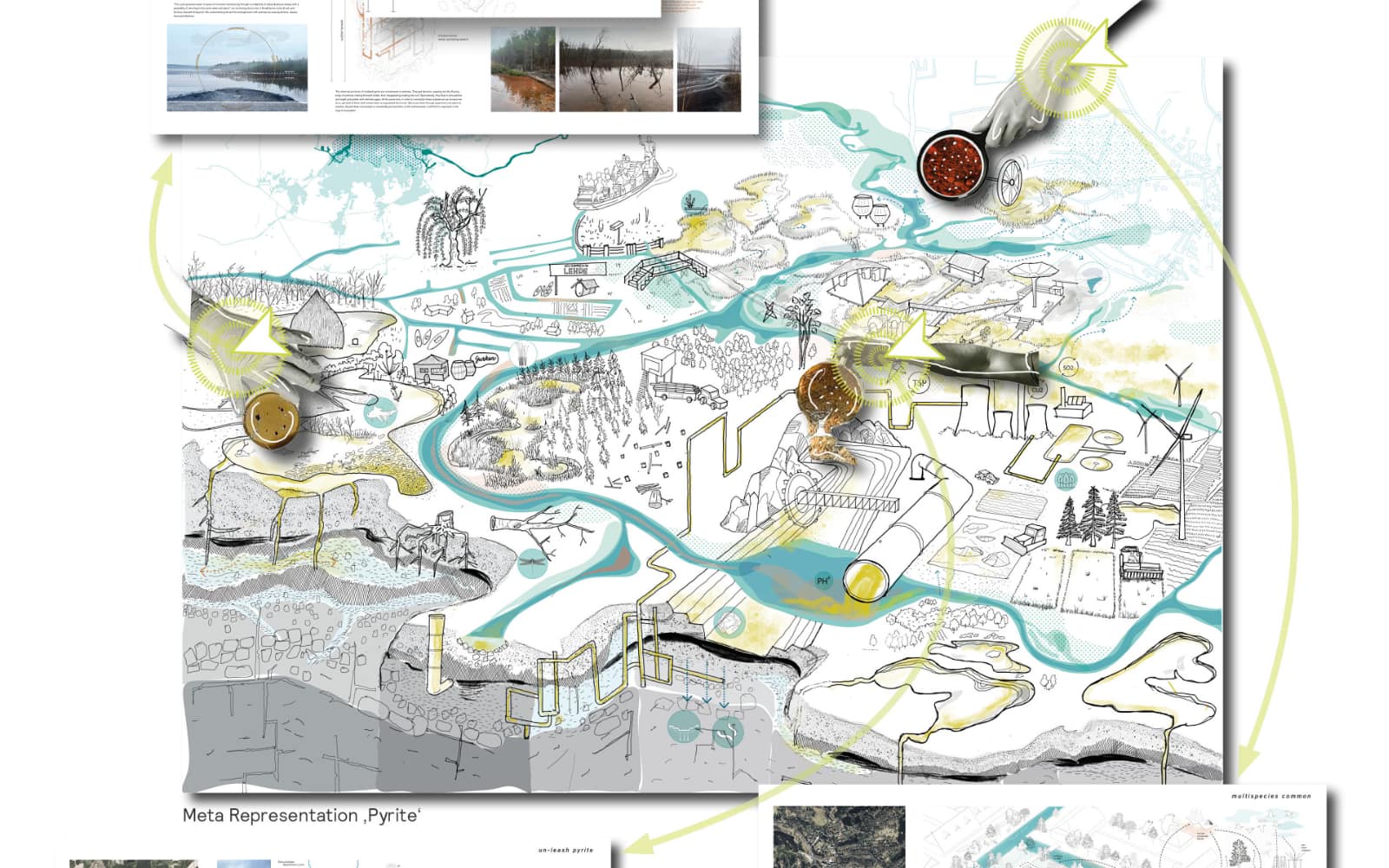Design-Agents in More-Than-Human Landscapes
Downloads
DOI:
https://doi.org/10.47982/spool.2025.2.03Keywords:
Re-representation, recursive design processes, more-than-human landscapes, mattering processes, transscalarity, patchiness, pluralismAbstract
This article explores the agency of representations to open up perspectives in more-than-human landscape design processes. It follows and investigates the approach of re-representations—multimodal assemblages that narrate landscapes as zones constituted by specific socio-material processes. Methods of research through and on design are combined: students’ experiments of designing with representations were set up in a landscape architecture design studio at the Technical University Berlin in the context of a deeply changing wetness regime in Lusatia, Germany. These design methods are investigated by synthesizing and comparing them with the aim of reflecting them in a post-humanist, new materialist discourse on the understanding of landscape and critical mapping. The findings concentrate on the most crucial agencies these re-representations have, to reorient design processes and reshape what is understood as landscape design in the shift to more-than-human worlds.
How to Cite
Published
Issue
Section
Categories
References
Aït-Touati, F., Arènes, A. and Grégoire, A. (2022). Terra Forma: A Book of Speculative Maps. Cambridge, Massachusetts; London, England: The MIT Press.
Arndt, S. and Heiland, S. (2024). Current status of water-related planning for climate change adaptation in the Spree River basin, Germany, Nat. Hazards Earth Syst. Sci. Discuss. [preprint], https://doi.org/10.5194/nhess-2024-59 DOI: https://doi.org/10.5194/nhess-2024-59-supplement
Barad, K. (2007). Meeting the Universe Halfway: Quantum Physics and the Entanglement of Matter and Meaning. Duke University Press. DOI: https://doi.org/10.2307/j.ctv12101zq
Haraway, D. J. (2016). Staying with the trouble. Duke University Press. DOI: https://doi.org/10.2307/j.ctv11cw25q
Hetzel, D., Usée, P., Goldmann, T., Münch, P., Brill, F. (2023, August 28). Flusspunkte entlang der Spree [River points along the Spree]. Umweltethnologie. https://umweltethnologie.com/2023/08/28/flusspunkte-entlang-der-spree/
Latour, B. and Weibel, P. (eds.) (2020). ‘Seven Objections Against Landing on Earth’, in B. Latour and P. Weibel (eds.), Critical Zones: The Science and Politics of Landing on Earth. Cambridge: The MIT Press, pp. 12–19.
Latour, B. (2018). Down to Earth: Politics in the New Climatic Regime. English edition. Cambridge, UK ; Medford, MA: Polity Press.
Latour, B. (2005). Reassembling the Social: An Introduction to Actor-Network-Theory. New York: Oxford University Press. DOI: https://doi.org/10.1093/oso/9780199256044.001.0001
Mathur, A. and da Cunha, D. (2020). ‘Wetness Is Everywhere, Why Do We See It Somewhere?’ in B. Latour and P. Weibel (eds.), Critical Zones: The Science and Politics of Landing on Earth. Cambridge: The MIT Press. DOI: https://doi.org/10.1080/10464883.2020.1693843
Neuhaus, A. (2025). Re-Representing Landscapes: An Investigation of a New Category in an Emerging Mapping Culture [preprint], https://www.preprints.org
Neuhaus, A. (2025, June 5). Re-Representing Mattering Landscapes: Outlining a New Method and an Emerging Culture. https://doi.org/10.31235/osf.io/cpyq2_v2 DOI: https://doi.org/10.31235/osf.io/cpyq2_v1
Niewöhner, J. and Hetzel, D. (forthcoming). ‘Ethnographisches Zusammenarbeiten’. [Ethnographic collaboration], in: K. Eitel and C. Wergin: Handbuch Umweltanthropologie. Bielefeld: Transcript Verlag.
Schindler, A. (Author). (2021). Ein Sumpf als Grenzobjekt: Wie kartographieren wir ein trockengelegtes Feuchtgebiet? [A Swamp as Boundary Object: How to Map a Drained Wetland?] [Video Essay]. Academia. https://www.academia.edu/video/k5Jq5j.
Tsing, A. L., Mathews, A. S. and Bubandt, N. (2019). ‘Patchy Anthropocene: Landscape Structure, Multispecies History, and the Retooling of Anthropology’, Current Anthropology, 60(20), pp. 186–197. Available at: https://doi.org/10.1086/703391. DOI: https://doi.org/10.1086/703391
Tsing, A.L. et al. (2021). Introduction to Feral Atlas, in Feral Atlas: The More-Than-Human Anthropocene. Available at: https://feralatlas.supdigital.org/index?text=introduction-to-feral-atlas&ttype=essay&cd=true (Accessed: 18 September 2023). DOI: https://doi.org/10.21627/2020fa
Umweltbundesamt Deutschland (ed.) (2023). Abschlussbericht Wasserwirtschaftliche Folgen des Braunkohleausstiegs in der Lausitz. Berlin: Verlag Umweltbundesamt.





